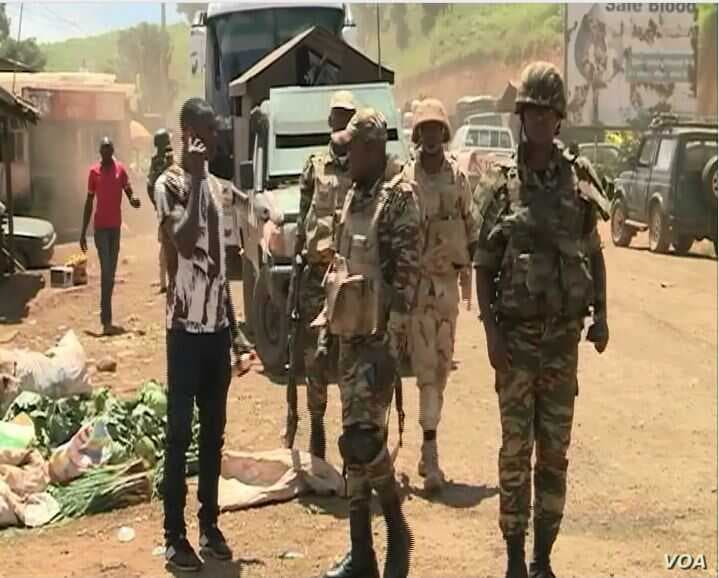YAOUNDÉ, Cameroon – As the Anglophone crisis enters it fifth year in Cameroon, Catholic Relief Services is stepping up to help the civilians affected by the conflict.
The insurgency began in the country’s English-speaking North West and South West regions in 2016, after the government violently suppressed protests by Anglophone teachers and lawyers complaining about discrimination by the French-speaking majority.
The conflict left at least 3000 people dead and forced over a million from their homes.
Catholic Relief Services, the international development arm of the U.S. bishops, has now set up the “Anglophone Crisis Emergency Response (ACER).”
“The project is designed to meet the immediate food and Non-Food Item (NFI) needs of 27,750 individuals in the Mezam Division of the NW, the division with the highest number of displaced families in the region,” said the ACER Project Coordinator for CRS.
He told Crux the project has already supported 27,758 individuals in 3,916 households.
“The conflict and displacement have upended livelihoods, limited people’s access to farmlands and income-earning opportunities, severely limited access to food, and left families without basic supplies,” he said. “Food insecurity remains a major challenge in the region and presents a key risk of malnutrition and human suffering.”
Following are excerpts of his interview.
Crux: Cameroon has been engulfed in a separatist war for nearly five years now. What has been the scale of displacement?
CRS: According to the OCHA Cameroon Situation Report from Dec. 30, 2020, the conflict in the North West and South West (NWSW) regions has affected over 3 million people and displaced over 1 million individuals. Over 705,000 people are displaced within the North West and south West regions, 360,500 have been displaced and since returned home, 61,300 people have fled to Nigeria as refugees, and over 300,000 more have been displaced to neighboring regions of the Littoral, Adamawa, Centre, and West of Cameroon.
CRS has launched the Anglophone Crisis Emergency Response, or ACER, project. What are the main points of that project and what have you achieved so far?
The Anglophone Crisis Emergency Response (ACER) is a 12-month project funded by USAID’s Bureau for Humanitarian Assistance (BHA). The project is designed to meet the immediate food and Non-Food Item (NFI) needs of 27,750 individuals in the Mezam Division of the NW, the division with the highest number of displaced families in the region. ACER’s goal is to alleviate suffering and improve food security of displaced and host households through improved access to sufficient, nutritious food and essential household items. Through ACER, CRS and its local partner, the Archdiocese of Bamenda, are delivering six rounds of food assistance and a one-time disbursement of funds for household items and hygiene supplies to families affected by the crisis.
The ACER project provides participants with e-voucher smart cards through which they receive credit to purchase food and household items at local markets. The project has almost 70 vendors participating in the project. To date, the project has already supported 27,758 individuals in 3,916 households, and as of December 2020, participants have received 5 rounds of food assistance and 1 round of NFI assistance, totaling $1,331,366. This intervention is already leading to marked improvement in short-term food security outcomes. At the start of the project, 82 percent of interviewed participant households were suffering from moderate or severe hunger. Following a survey in September 2020, almost halfway through the project, this percentage dropped to only 42 percent.
How is the COVID-19 pandemic affecting the program?
With the onset of COVID-19 just prior to the project start, CRS and the Archdiocese of Bamenda quickly adapted the project activities to ensure adherence to preventative measures that would keep project staff, participants, and vendors safe. For example, ACER limited the size of groups attending project start-up events and registration activities. The project distributed reusable cloth facemasks to all participant households prior to the first top-up and sends messaging to participants and vendors prior to each credit top-up to encourage adherence to the COVID-19 preventative measures. This messaging is continued through onsite monitoring during shopping days. Other adaptations have included the use of more remote monitoring methods.
How do you go about identifying potential beneficiaries?
Community collaboration has been a key targeting strategy for the project, improving acceptance and feedback through the involvement of beneficiary committees with community representatives to identify potential beneficiaries and validate the final list of participants. The committees helped ensure transparency and data accuracy and allowed the project to select the most vulnerable beneficiaries for the project. The ACER project has continued this community engagement and collaboration throughout the project by holding reflections with project stakeholders and participants at key milestones to solicit feedback on project implementation, what went well and what needs to be improved.
What are those displaced by the conflict facing today?
The conflict and displacement have upended livelihoods, limited people’s access to farmlands and income-earning opportunities, severely limited access to food, and left families without basic supplies. Food insecurity remains a major challenge in the region and presents a key risk of malnutrition and human suffering.
Most displaced households adopt negative coping strategies, relying on less preferred food, borrowing food from relatives, reducing portion sizes at meals, reducing consumption by adults, and purchasing less expensive, and in many cases, less nutritious food. Displaced people in the NWSW region also face limited access to health, water, and sanitation facilities as well as education. Due to the destruction of health facilities and insecurity, IDPs are turning to alternative traditional healers for healthcare.
Education poses another major challenge for most families in the region, as most schools have been closed for almost four years, and those that have reopened have faced attacks. About 80 percent of displaced children do not go to school, mainly due to school closures, general insecurity, and lack of teachers. This gap in education is already leading to developmental gaps in literacy and numeracy. Lower educational levels are associated with high protection risks, child labor and exploitation, an increase in child pregnancies, higher child and maternal mortality rates, and reduced incomes. Having children at home instead of school has also significantly increased women’s workload.
Armed groups continue to prevent the populations from freely and safely pursuing their economic activities with continuous weekly “ghost town” days, one day each week that non-state armed groups mandate that people stay at home and businesses stay closed. There are also frequent lockdowns related to security incidents or political events and illegal roadblocks along major supply routes, thereby slowing access and humanitarian aid. In addition, humanitarian workers have been victims of harassment, extortion, illegal kidnappings and killings, and other abuses.

















